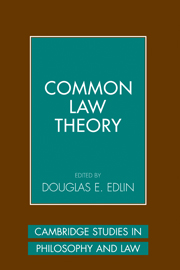Book contents
7 - Text, Context, and Constitution: The Common Law as Public Reason
Published online by Cambridge University Press: 17 September 2009
Summary
Introduction
In anglophone legal systems, the common law provides a constitutional foundation for legitimate government. It embodies a tradition of governmental compliance with the rule of law, subjecting official decisions and actions to independent judicial scrutiny. The evolution of common law principle, prompted by changing moral attitudes within society at large, provides for the adaptation of traditional values to present conditions. It enables the abstract clauses of a “written” constitution to acquire new meaning and gives an “unwritten” constitution its principal legal content. In performing such important tasks, moreover, the common law presupposes a distinctive vision of liberal democracy: It aspires to nurture and sustain a coherent constitutional morality, reflecting widely shared commitments to a fundamental ideal of equal justice. In a common law legal order, authoritative texts – whatever their formal status – are interpreted as elements of that larger constitutional design. Their true meaning and legal consequences are always matters of conscientious moral judgment, undertaken within the context of a strong legal tradition: The exercise of power is everywhere subject to moral scrutiny and the standing requirement of reasoned justification.
In the context of a common law rule, the notion of legal “validity” is largely redundant. The rule announced by the court in an earlier case may be relevant to the current inquiry, yet have little or no force.
- Type
- Chapter
- Information
- Common Law Theory , pp. 185 - 203Publisher: Cambridge University PressPrint publication year: 2007
- 2
- Cited by

